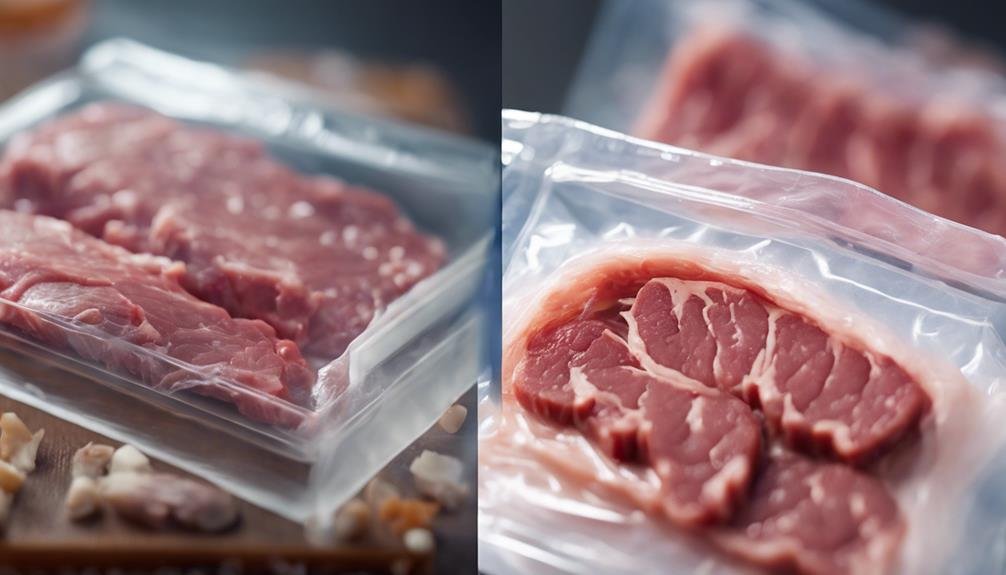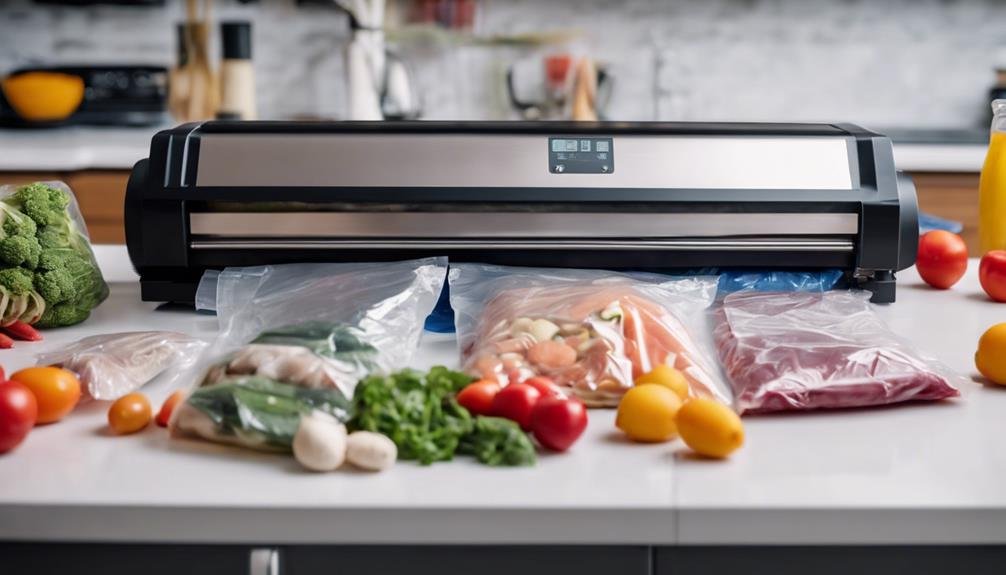Vacuum sealing is an important technique to inhibit bacterial growth and extend your food's shelf life. By removing air and creating an anaerobic environment, it eliminates oxygen that harmful bacteria need to thrive. This method is highly effective for preserving meats, fish, dairy, fruits, and vegetables. To maximize its benefits, you'll need a quality vacuum sealer and proper bags. Mastering the right techniques is essential for creating an airtight seal and removing as much air as possible. When done correctly, vacuum sealing can greatly slow down spoilage and maintain food quality. Discover how this technology can revolutionize your food preservation practices.
Understanding Vacuum Sealing Technology
How does vacuum sealing technology work to keep your food fresh and safe? It's all about creating an environment where harmful bacteria can't thrive. Vacuum sealing removes air from food containers, effectively reducing oxygen levels. This process creates an anaerobic environment, which is vital for food preservation.
You might wonder why eliminating oxygen is so important. The answer lies in understanding how bacteria behave. Many harmful bacteria require oxygen to multiply and survive. By removing oxygen, vacuum sealing inhibits the growth of these microorganisms, particularly anaerobic bacteria like Clostridium botulinum.
When you use vacuum sealing technology, you're essentially establishing a barrier against bacterial proliferation. Without oxygen, these harmful microbes can't develop and spread, ensuring your food remains safe for consumption. This method is particularly effective in extending the shelf life of various food items.
It's important to note that vacuum sealing doesn't just prevent bacterial growth; it also helps maintain food quality. By limiting microbial activity, your food stays fresher for longer periods. This innovative approach to food preservation offers you a practical solution for keeping your meals safe and delicious.
Benefits for Food Preservation
Now that you understand how vacuum sealing works, let's explore its substantial benefits for food preservation. Vacuum sealing is a powerful technique that inhibits bacterial growth, extending the shelf life of your food. By removing oxygen from the packaging, you're creating an environment where many harmful bacteria can't thrive.
One of the most important advantages of vacuum sealing is its ability to prevent the growth of dangerous bacteria like Clostridium botulinum, greatly reducing your risk of foodborne illnesses. Additionally, this method slows down enzymatic and microbial reactions that lead to spoilage, keeping your food fresher for longer.
Here's a quick comparison of food preservation methods:
| Method | Bacterial Growth Inhibition | Extended Shelf Life | Mold Prevention | Oxygen Removal |
|---|---|---|---|---|
| Vacuum Sealing | High | Excellent | Very Good | Complete |
| Refrigeration | Moderate | Good | Moderate | None |
| Freezing | High | Excellent | Good | None |
| Canning | High | Excellent | Very Good | Partial |
| Drying | High | Good | Good | Partial |
Proper Vacuum Sealing Techniques

To effectively inhibit bacterial growth, you'll need to master proper vacuum sealing techniques that guarantee an airtight environment for your food. The key to successful food storage lies in creating an anaerobic environment that prevents the proliferation of harmful bacteria and aerobic micro-organisms.
When vacuum sealing, your primary goal is to remove as much air as possible from the packaging. This process greatly reduces the oxygen available for bacteria growth, extending the shelf life of your food. It's important to make sure that you're applying adequate vacuum pressure and allowing sufficient sealing time to create a robust, airtight seal.
Remember, even small pockets of air can compromise the effectiveness of your vacuum sealing efforts. Pay close attention to the edges and corners of your packaging, as these areas are prone to trapping air.
By following recommended procedures and using appropriate equipment, you'll create an environment hostile to spoilage microorganisms.
Proper vacuum sealing techniques not only inhibit bacterial growth but also maintain food quality. As you perfect your skills, you'll find that this method of food preservation offers a reliable way to keep your stored items fresh and safe for extended periods.
Best Foods for Vacuum Sealing
When it comes to inhibiting bacterial growth, you'll find that certain foods are particularly well-suited for vacuum sealing. Meats, fish, and dairy products top the list, as vacuum sealing effectively extends their shelf life by creating an environment that hinders bacterial proliferation. You'll be pleased to know that this method of preservation not only maintains the quality of these foods but also guarantees their safety for consumption over longer periods.
Fruits and vegetables also benefit greatly from vacuum sealing. By removing air and creating a sealed environment, you're able to prevent microbial deterioration and keep your produce fresher for extended durations.
Cheese lovers will appreciate that vacuum sealing their favorite varieties helps inhibit mold and bacteria growth, preserving both flavor and texture.
If you're a seafood enthusiast, you'll be glad to learn that vacuum sealing is an excellent way to store shrimp and scallops, preventing bacterial contamination and preserving their quality.
To conclude, don't overlook the benefits of vacuum sealing cooked meals like soups and stews. This method inhibits bacterial growth, ensuring your prepared dishes stay fresh and safe to eat for longer periods.
Equipment and Supplies Needed

You'll need several key pieces of equipment and supplies to effectively vacuum seal and inhibit bacterial growth in your food. The cornerstone of your setup is a quality vacuum sealer machine with appropriate settings for creating airtight seals. This device is important for removing air and preventing bacteria from thriving in your stored food.
Equally important are high-quality vacuum sealer bags designed for best air removal and durability. These bags are essential for maintaining the integrity of your sealed foods and keeping bacteria at bay.
To enhance your sealing process, you might consider optional accessories like jar sealers and vacuum canisters, which can expand your storage options.
Proper maintenance of your vacuum sealer is essential. Regular cleaning and timely bag replacement ensure consistent performance and effective bacterial inhibition.
Understanding and applying correct vacuum sealing techniques, such as double-sealing for extra protection, is key to maximizing the bacteria-fighting potential of your equipment.
Conclusion
You've now discovered the secret to keeping your food fresher for longer. Like a time capsule for your meals, vacuum sealing is a game-changer in food preservation.
By following proper techniques and choosing the right foods, you'll reduce waste and save money.
Don't let this powerful tool gather dust in your kitchen. Embrace the vacuum sealing revolution and watch as your food stays fresh, flavorful, and bacteria-free for weeks to come.
